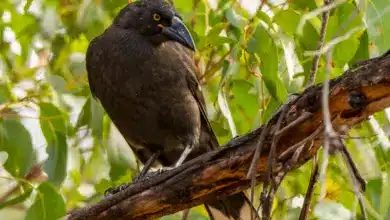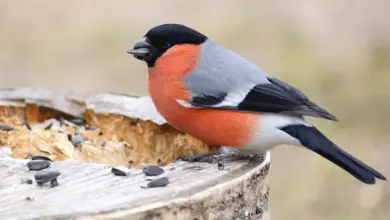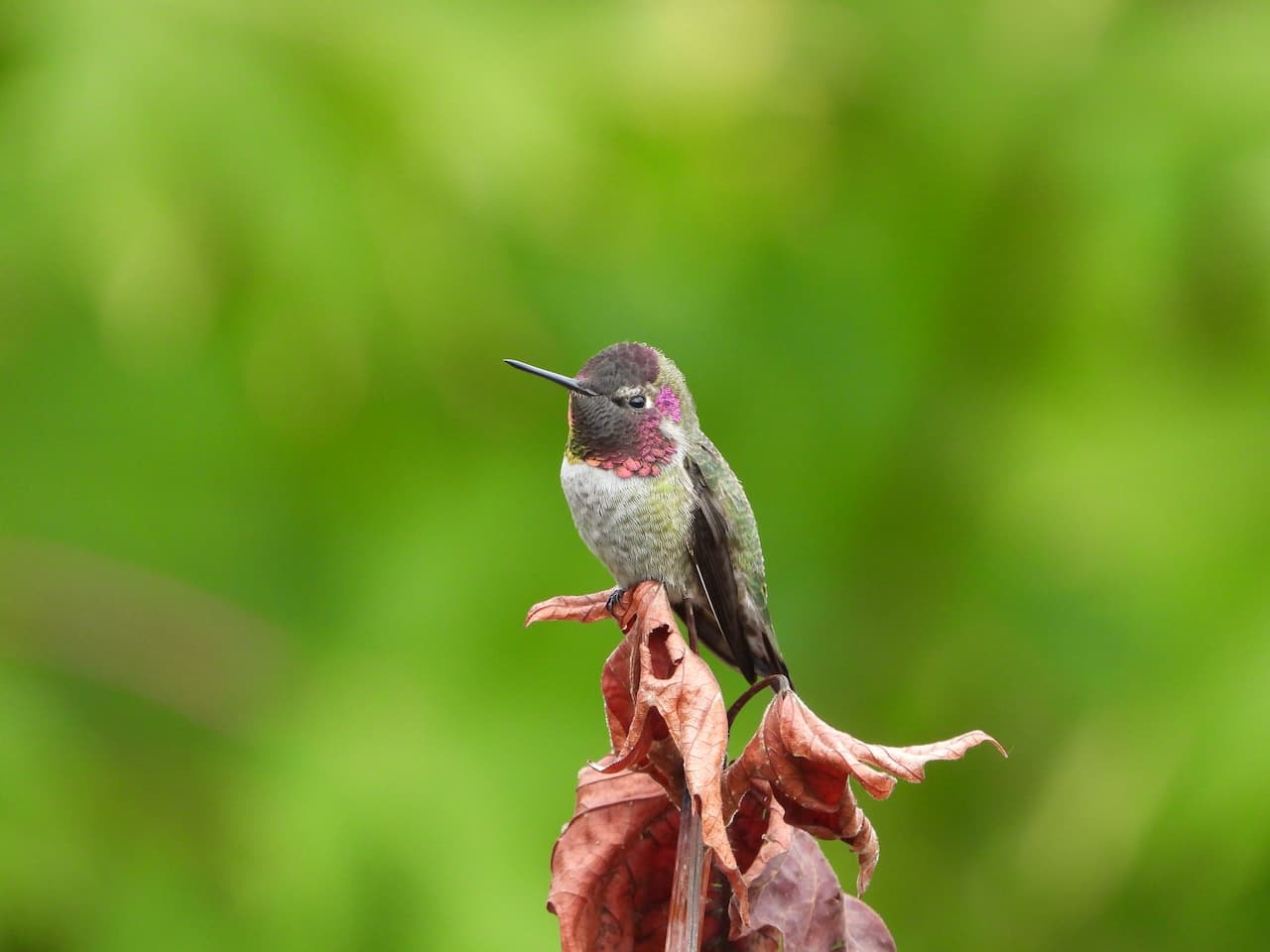Pinyon Jays
The Pinyon Jays (Gymnorhinus cyanocephalus) – also known as Blue Nutcrackers or Maximillian’s Jays – are colorful members of the crow family.
They are found on the lower mountain slopes of the western United States.
As suggested by this species’ common name – these jays are closely associated with pinyon (pine) trees, which they use for cover, nesting, and feeding. In fact, in years when the pine seed crop is low, the population of jays typically drops. Even though these birds are mostly sedentary (non-migratory), they will disperse far from their home range when food is no longer readily available.
Pinyon Jays have been shown to have a remarkable memory. These smart birds store thousands of excess seeds each year and have demonstrated their ability to find these hidden seeds months later – even when covered under snow. Bonded pairs seem to coordinate their food caching so that the locations are known to each other.
Outside the breeding season, these highly social birds are often found in large, loose flocks with as many as 500 birds that maintain a distinct social hierarchy, and they tend to remain in the same flock they were born into. However, the composition of the flock changes dramatically during the breeding season, when breeding pairs separate from their flocks.
Distribution / Habitat
Pinyon Jays are residents in western North America from central Oregon south through eastern California and northern Baja California. They range east to Montana and western South Dakota and south to northwestern and east-central Arizona, central New Mexico, and extreme northwestern/western Oklahoma.
Non-breeding vagrants are known to occur in southern Washington east through northwestern Montana and North Dakota – rarely as far as Iowa – and south to western Texas and Mexico (in the northern state of Chihuahua). Isolated Pinyon Jays have been reported as far north as British Columbia and Saskatchewan in southern Canada.
They inhabit and breed in pinyon-juniper woodlands and ponderosa pine forests (Pinus edulis, Pinus ponderosa, Pinus monophylla, Juniperus occidentalis, etc.), and forests of mixed pine and oaks.

Description
Size
- Length: 9 – 11.4 inches (23 – 29 cm)
- Wingspan: 18.11 inches (46 cm)
- Weight: 3.2 – 4.2 oz (90 – 120 g)
Plumage Details / Adults
- Plumage overall bluish-grey
- Deeper blue on the head
- Greyish-white throat
Other Physical Details
- Relatively long, sharply pointed, black bill with some geographical variations; northern populations tend to have thinner and shorter bills than those found in the southwestern regions
- Bill is featherless at its base (hence its Latin name Gymnorhinus = bare nostrils) – distinguishing them from nearly all other members of the family Corvidae
- Dark brown or black eyes
- Black legs and feet
- Long, strong wings
- Short tail
Gender ID
- Male’s bill is longer
- The male’s head is darker
Juvenile Description
- Juvenile plumage is dull grey
Similar Species
- Lack the crests seen in other jays
- Blue Jay (Crested)
- Steller’s Jay (Crested, blackish-brown-headed heads – although head color gradually turns bluer farther south)
- Mexican Jay (Crested. Ranges overlap in parts of Arizona, New Mexico, and Texas – paler below)
- Western Scrub-Jay (Within its range, but the white-streaked throat and paler below)
- Island Scrub-Jay (Found on the island of Santa Cruz off the coast of Southern California)
- Florida scrub jay (Out of its natural range)
Diet / Feeding
Their preferred food items are the seeds of Pinyon pine trees, in addition to taking acorns, soft green food, fruits, juniper berries, and other wild berries, cultivated grains (such as corn, sorghum, beans, barley, oats, and wheat), lizards, snakes, the eggs and nestlings of other birds, and small mammals.
They will also take insects and their larvae, including caterpillars, beetles, grasshoppers, ants, and spiders.
Breeding / Nesting
Nesting typically commences in late February and goes on until April. However, in some areas nesting may occur at just about any time of the year, as long as climatic conditions are favorable and food is plentiful. If these variables are met, a second clutch may be produced later on in the year (mostly around August).
Pine Jays establish monogamous pair bonds but may choose new mates if their previous mates are lost.
The nests are typically placed close to their favorite food sources. Even though these birds always nest in colonies, there never is more than one nest in each tree (usually juniper, live oak, or pine). The nests are generally 50 – 500 feet (15 – 152 meter) apart from each other and built at an average height of 18.4 feet (5.6 meters) off of the ground. The large, bulky open-cup nests are constructed out of twigs, shredded bark, grasses, pine needles, and rootlets. However, they may incorporate anything suitable from their environment into their nests; such as feathers, horsehair, as well as paper, cloth, and trash collected from urban areas.
A clutch may consist of 3 – 5 pale blue, dark speckled eggs. However, in most cases, a nest contains 4 eggs in average years and when food isn’t readily available, three eggs or fewer are laid.
The incubation lasts 16 to 17 days and is performed by the female. During this time, the male will take food to the female and guard the nest. As the young grow, other members of the flock may help feed them.
The chicks fledge when they are around three weeks old.
Calls / Vocalizations / Sounds
Their vocalizations include rhythmic and nasal “crauk-crauk”, “kaa-eh”
https://www.xeno-canto.org/embed.php?XC=153396&simple=1
Alternate (Global) Names
Chinese: ??? … Czech: Sojka modrá / modrohlavá … Danish: Pinyonskade … Dutch: Pinyongaai … Estonian: männi-sininäär … Finnish: Mäntynärhi … French: Geai à tête bleue, Geai des pinèdes … German: Nacktschnabelhäher … Hungarian: csupaszcs?r? szajkó … Italian: Ghiandaia dei pini / delle pinete … Japanese: matsukakesu … Norwegian: Pinjeskrike … Polish: modrowroniec … Russian: ??????????????????? ?????, ???????? ????? … Slovak: kapuciarka borinová … Spanish: Chara Piñonera, Urraca Piñon … Swedish: Tallskrika
Life Cycle
Their life expectancy in the wild is about 16 years.






